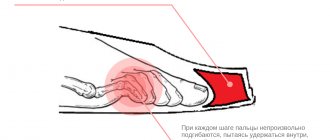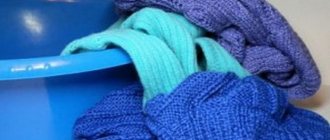What is this text about? In this text we will answer the following questions: the skirt is electrified to the tights, what to do, what to do if the dress sticks to the tights, the dress is magnetic to the tights, what to do, what to do to prevent things from becoming electrified
Everyone has encountered a problem when things made of synthetics, wool or natural silk lose their shape, do not flow, but stick to the body and even sparkle. Electrification of fabrics spoils the appearance of the outfit and causes discomfort.
This process is associated with dryness, and you can easily get rid of it or prevent electrification even before putting on the outfit. Let's figure out what to do to prevent clothes from becoming electrified.
The dress sticks to the tights. What to do?
What can you do to prevent your skirt from sticking to your tights if there is no antistatic agent? You can try one of the following methods:
- Apply a thin layer of hand cream to your feet. The appearance of moisture significantly reduces friction.
- Apply a small amount of baby powder to areas of skin that are exposed to static electricity in clothing.
- Run a bar of soap over your tights or the inside of your dress.
- To urgently solve the problem of electrification of clothes, you can apply a little fabric softener to your hands and run them over your tights.
- Wet your hands in a solution of 1 teaspoon salt and a glass of water. Run your hands over the clothing several times.
- When rinsing synthetic clothing, use a special fabric conditioner with an antistatic effect.
Important! Before using such conditioners, read the instructions. It may not suit all types of fabric
- Clear water can also help remove static electricity. To do this, run wet hands over the clothing. The only significant drawback of this method is the short duration of the result.
- The right shoes can solve this problem. Shoes must be leather or have rubber soles. Insoles or strips with an antistatic effect are also quite effective.
- Antistatic wipes do a great job of solving the problem. Lift the skirt and rub it with a napkin from the wrong side. This way the static will instantly transfer to the napkin.
- Most often, static electricity occurs in winter, when indoor air is dry. Air humidifiers cope well with the problem: the electrification of the air will disappear some time after the humidifier starts operating.
- To remove static electricity from a dress, hang it in the bathroom for a few minutes immediately after showering. Increased humidity neutralizes static electricity.
- Hard water is one of the causes of electrification of tissues. Using conditioners to soften the water when washing, you will prevent the accumulation of static charges on fabrics.
What available means can replace antistatic agents?
When an antistatic agent is not at hand, you can turn to traditional methods:
- Water. The most affordable tool that is always at hand. Pour water into a spray bottle and spray onto the fabric. As a last resort, you can run it along the hem with a damp palm.
- Vinegar. If time allows, rinse the product in a weak vinegar solution. After the item dries, the problem will be solved.
- Air conditioner. Use fabric softener when washing synthetic fabrics to avoid static discharge. If you need a solution here and now, apply a little conditioner to your palm and rub it along the underside of your skirt.
- Soap. Use a bar of toilet soap to go over the tights or the inside of the hem.
Dealing with static electricity is not difficult. The main thing is to properly care for your clothes and always have a couple of reliable secrets in your arsenal.
Subscribe to our Social networks
A combination of synthetic tights and faux fabric dresses
The main problem in the contact of synthetic materials remains the sticking of skirts to tights. The skirt not only gets tangled in the legs and loses its shape, it also rises above the proper level.
There are a number of other effective ways to combat this problem:
- If you apply a thin layer of hand cream to the skin of your legs before putting on tights, you can create the desired effect. Increased humidity under the tights will reduce friction.
- You can also apply a little baby powder to the parts of your legs where you experience the most friction.
- A piece of dry soap can also help - you need to run it along the tights or on the wrong side of the dress.
- A little fabric softener can instantly solve the problem. Just wet your hands in this product and rub it over the tights.
- If you make a solution of 1 teaspoon of salt and a glass of water and run your hands soaked in it over your legs in tights, then the issue with electrification is also very successfully resolved.
- Even plain water can help - just wet the tights right on your feet. But as soon as the water evaporates, the effect disappears.
- A special air conditioner with an antistatic effect will also come to the rescue. It needs to be diluted in water and rinsed with clothes.
Important to remember! These products are not suitable for all types of fabric. Interesting fact: the right shoes can reduce the level of static electricity buildup
Shoes must have rubber or leather soles. You can also choose antistatic insoles or strips cut from antistatic wipes
Fun fact: The right shoes can reduce the build-up of static electricity. Shoes must have rubber or leather soles. You can also choose antistatic insoles or strips cut from antistatic wipes.
Humidifying the air in the room will help partially solve the problem of fabric sticking. Moisturizing the dress itself has the same effect.
Another reason for skirts sticking to your legs, besides dry air, is hard water. Washing conditioner will help get rid of this factor.
- What to do with your wedding dress after a divorce
As you can see, it is absolutely not necessary to acquire an antistatic agent in order to overcome the problem of synthetic skirts sticking to tights. The issue can be resolved using a wide range of available means.
Antistatic in the service of lovers of synthetics
The beauty and durability of synthetic items is sometimes unpleasantly offset by the need to constantly adjust the skirt, tearing it off the tights. The simplest and most common way to combat this phenomenon is to purchase an antistatic agent.
Important! You cannot process tights and a skirt at the same time - this will only aggravate the situation.
The variety of such products on store shelves is extremely wide. In addition to solving the problem with a sticky skirt, you can get rid of small hairs, lint and dust that stick to nylon and nylon tights. This is definitely a useful property of an antistatic agent, since small debris spoils the appearance of clothes and the image as a whole.
Something to remember! Antistatic agent has an unpleasant odor, so it is better to spray it in a well-ventilated area.
We invite you to familiarize yourself with No yellow tint on the windows! Current tips on how to bleach tulle at home
You can buy a bottle of the substance at every hardware store. But if it is not at hand, then you can use one of the methods below.
How to soften a scratchy linen dress
Of course, the quality of clothing should be considered at the purchasing stage. But if it’s already done, then don’t despair and put the item in the closet. It is enough to resort to little tricks, and you can wear clothes without fear of discomfort. We'll show you how to soften scratchy fabric.
Fabric softener
- Soak clothes in warm water with added conditioner for half an hour.
- Wring out and place in the washing machine.
- Add the product to the desired compartment.
- Select the appropriate program.
- If necessary, perform the procedure several times.
Boiling with soap and soda
This method is quite aggressive, so if the fabric is brightly colored, it is better not to use it.
Both regular baking soda and the calcined version will work for processing.
- Use 3 tbsp per bucket of water. l. grated laundry soap and a spoonful of soda.
- Prepare the solution and bring it to a boil.
- Place clothes in it and boil over low heat for 30 minutes.
- Then rinse in clean water with the addition of a spoonful of vinegar (it will help wash away any remaining soap from the fabric).
Rinse with conditioner and freeze
Another great home remedy is a conditioner. By adding it every time you wash, you can get rid of the prickliness.
You can soften rough linen by placing the material in the freezer after washing with fabric softener for a day.
What to wear with a black dress: long and small; in the office and on the street. photo
Lining
The lining layer will help protect the skin from the rough surface of the fabric. It is usually made from synthetics. This option is especially suitable for trousers, jackets and jackets. For a skirt, a petticoat can serve as a good replacement for the lining. The beauty of this piece is that the same petticoat can be used for different skirts.
Water softening
Do not forget that the main cause of prickly and rough tissue is hard water. Therefore, for prevention, add softening agents when washing.
Remember the temperature conditions for washing and ironing, ensure proper care of the item, and then it will serve you for a long time without unpleasant surprises.
Why do tights fall off?
There are several main reasons why tights may constantly fall down. The first and most obvious of them is the discrepancy between the size of the model and the body proportions of its owner. For example, when a thing is smaller than the required size, its elastic fabric is constantly tightened, and therefore regular slippage occurs due to the lack of reliable adhesion and fixation.
The same applies to larger sizes, only in this case, due to the lack of volume, folds appear on the fabric. They, in turn, begin to pull together according to the accordion principle, since the fabric is elastic. Consequently, such a product will also regularly slide down.
Another common reason is the quality of the product, because it often happens that the model is chosen according to size, but still does not fit. This is due to the poor quality of the elastic at the waist, which actually serves as the main fastener for this clothing. If it is too weak or stretched, then even if it fits perfectly on your figure, such tights will slide down.
Since many girls have very smooth and elastic skin due to regular use of various body cosmetics, this may cause the material to have poor adhesion to it. Simply put, tights will simply slide and fall off, regardless of the size of the product and the quality of the material, in particular the elastic.
Patterns and procedures for sewing clothes for a doll yourself
Lining is important
If the item is of high quality, then it will have a lining. Thanks to the simple fabric under the skirt, you will feel pleasant comfort and will also avoid the trouble of the skirt sticking. But many manufacturers, in order to save money, make the lining from synthetic fabrics, thereby creating problems for us. Take some time to line your skirts and dresses. It’s better to turn to a professional and sew everything in perfect shape.
What to do if your curls become electrified
It is better to buy a quality comb. The comb should be made of natural material. Wood, bone, carbonate and other materials may be suitable for these purposes. There are silicone combs with antistatic characteristics. Some plastics are also a good option. Given the existing problem of this property, the headdress must be removed inside the building, which you really don’t want to do, but it is necessary. When washing your hair, you should make it a rule to rinse it with a decoction of tea, herbs, or just water at a low temperature. Hair is dried only in the direction of its growth.
Proper nutrition will help solve the problem of electrification. You need to take vitamins with zinc and biotin. This will improve health and improve the condition of the body. You need to understand that most often the electrification effect is characteristic of overdried curls. If you moisten them, the issue will be removed from the agenda. A moisturizing hair mask will be very useful. It is quite possible to do it yourself. Washing your scalp every day will significantly improve the condition of your hair. It is better to make it a rule to wash your hair every two days.
Restoring masks have proven themselves to be quite good. They are sold in specialized stores. Well, a lot of folk remedies will be an important help. Don't neglect leave-in conditioner. It is applied to a damp head. It lasts until the next wash. The conditioner works like a face cream. To improve electrostatics, you can use an ionic hair dryer for drying. Any drying has a negative effect in this case. The strands become brittle and become thinner. A curl serum and an ionic hair dryer can protect you from troubles.
What is better not to do when electrifying curls?
Clips, hairpins and elastic bands must be used very carefully. Hair should not be too tight. You need to reconsider your wardrobe. Clothes made from natural fabrics are preferred. If you have to wear synthetics, they should be periodically treated with antistatic agents. These substances should not come into contact with the skin or head. At low temperatures outside, indoors, your hair can only be corrected some time after entering.
How to rinse things so they don't get electrified
Pay special attention to rinsing, since the use of some folk remedies effectively prevents electrification of clothes. Moreover, you can prepare these remedies at home.
To do this, use vinegar, salt and soda, citric acid and even hair conditioner. Let's look at a few ways to prevent clothes from sticking to your legs and tights:
- Mix vinegar and baking soda in a ratio of 6 to 1. Add the mixture when rinsing. This product reduces the ability of fabrics to accumulate static electricity, softens and refreshes the material, and completely removes residues of washing powder or soap from products;
- Mix vinegar, water and hair conditioner in a ratio of 3:6:2. Add the prepared solution when rinsing synthetics;
- When rinsing, add table salt or citric acid in a volume of one teaspoon per 10 liters of water.
Combine synthetic clothing with items made from natural fabrics. This greatly reduces the risk of static electricity. There is another little trick that helps avoid the accumulation of static.
Walk through synthetic materials barefoot, laying the products on the floor. And then the charge will go into the floor covering, and a small amount of charged particles will remain on the body.
What to do if your dress sticks to your tights
Antistatic - what can be replaced with
The dress sticks to the tights. What to do? What can I do to prevent my dress from sticking to my tights? “This question worries many women, because synthetic fabrics have long been included and firmly rooted in our daily lives. They are quite reliable to wear and have a beautiful appearance, so it is very difficult for us to completely abandon them. Many people have a special product at home that helps get rid of static electricity - an antistatic agent. If you do not have such a product on hand and you need to make sure that the dress does not stick to the tights, in this article we will offer you alternative but effective methods that can be used instead of an antistatic agent.
What to do if your dress sticks to your tights
What to do to prevent things from being electrified. What to do if the dress sticks to the tights
What to do if there is no antistatic agent?
Since the antistatic agent has a chemical composition, it may cause an allergic reaction in some people. Other ladies prefer not to buy antistatic for some other reason. In this case, what can be done to prevent the dress from sticking if there is no antistatic agent? Prepare it yourself using available ingredients.
You can do this in one of the following ways:
- Use vinegar when rinsing synthetic clothing. This will not only help reduce the ability of the material to accumulate static electricity, but will also completely remove any remaining soap or laundry detergent from the laundry.
- Mix 6 parts vinegar to one part baking soda. Half a cup of this mixture while rinsing will get rid of static electricity and will perfectly soften and refresh the fabric. The result is that you don’t have to worry about what to do to prevent your skirt from sticking to your tights.
- Another effective way to prevent your dress from sticking to your tights is to use hair conditioner. Take two parts of any hair conditioner, three parts of vinegar and six parts of plain water. To achieve the desired effect, use half a glass of the prepared solution when rinsing synthetic items.
- Table salt can also help solve this problem. Add salt to the rinse water. Just 1 teaspoon per 10 liters of water is enough. This product helps very well if your dress sticks to your legs or gets electrified.
- You can also use water with a small amount of citric acid for rinsing. The proportions are the same as in the salt method.
- Some housewives put a few tennis balls in the clothes dryer. In the same way, you can insert an antistatic wipe into a damp dress. After drying, static electricity does not appear on clothes.
- Another recipe for making an antistatic agent is a mixture of a few tablespoons of store-bought fabric softener and a glass of water. The well-mixed solution is poured into a spray bottle and sprayed onto dry clothes. This product is just as effective for removing static electricity from carpets.
Important! By combining synthetic items with clothing made from natural fabrics, you will significantly reduce the risk of static electricity.
Do you want to always look irresistible and feel comfortable? It’s very easy to wear new clothes every day! How? - Sew dresses with your own hands - we will tell you how to do it quickly and without a pattern!
What can I do to prevent my dress from sticking to my tights?
Knitted dresses and skirts especially often stick to tights, negating the entire effect of a beautiful outfit. To resolve this issue, use one of the following recommendations:
Before putting on tights, lubricate your legs with a moisturizer, which will significantly reduce friction. The main thing is not to overdo it, otherwise greasy marks will appear on the dress. Also, fabrics will be less electrified if you treat your feet with baby powder or scented talcum powder for the skin. The easiest and fastest way is to wet your hands a little with water and run them along the inside surface of the clothing. The main disadvantage of this method is its fragility. After the moisture evaporates, things will begin to become electrified again. Adding table salt to the water (1 tsp per 250 ml) will help prolong the effect of the previous recipe. For greater convenience, water or saline solution is poured into a spray bottle and sprayed onto the fabric. Some girls successfully replace the aerosol antistatic agent with hairspray. But such a product must first be applied to a small, inconspicuous area of tissue to see how it reacts to a foreign substance. In addition, hand sanitizer in the form of a spray or antibacterial wet wipes can come to the rescue. Since they contain alcohols, they will temporarily reduce the sticking of synthetics. You can also use a dry bar of soap. They need to treat the inner surface of the hem or tights. Just test it first: run a piece of soap over an inconspicuous area of the outfit. Some chemicals contained in soaps can discolor the fabric and form whitish spots on it. It is also acceptable to run your hands soaked in fabric softener over the clothes. You just need to wet them just a little, otherwise the product will leave stains on the fabric. Please read the instructions for the product first. They indicate the types of fabrics for which it is intended. It is acceptable to replace laundry detergent with hair conditioner.
The rules are the same: caution and moderation. The previous recipe can be improved. To do this, dissolve a couple of spoons of conditioner in a glass of water, pour the mixture into a spray bottle and spray it on your clothes. Another simple way is to wipe the fabric with an antistatic cloth, which collects all the electrical charge. If you combine synthetic items with natural materials, they will become much less electrified.
For example, stockings with a cotton lace corset are a good alternative to tights.
Video: how to replace antistatic agent?
Many tips can be used even “in the field” if you are already visiting, at work, in a restaurant, etc. But it is much more effective to take care of processing your outfit in advance, even at the washing stage.
Read further:
Everyone has had to observe how, when getting out of the car, when taking off clothes, a spark jumps between the body and objects and a tingling sensation is felt. Thus, static electricity manifests itself, caused by the accumulation of opposite charges on items of clothing. The size of the spark can be quite large, and the electric shocks can be noticeable and unpleasant. The fact is that the potential difference (voltage) on clothing reaches several thousand volts. Let this figure not scare anyone - the current power is negligible and static cannot cause any harm other than small pricks in the finger. It’s another matter when the discharge occurs at a gas station. At a certain concentration of gasoline or gas vapor, the mixture can ignite from the slightest spark. You can watch the refueling tank. A metal chain runs down the back of the car to remove static charge when the metal rubs against the ground.
What to do if it is not there or it does not help?
Unfortunately, this simple option does not always work. In some situations, an antistatic agent does not help, then you have to turn to folk remedies and use available ingredients. They also help out if you simply don’t have an antistatic agent on hand or you can’t use it because of an allergy.
- Mix a 9% vinegar solution with baking soda in a 6:1 ratio. Pour half a glass of this mixture into water and rinse the synthetic dress in it.
- Another recipe is recommended for rinsing. Dilute conditioning hair conditioner and 9% vinegar with water in a concentration of 2:3:6. You also need to add half a glass of the product.
- You can use regular table salt. For a ten-liter volume of rinsing water, one teaspoon of salt is enough.
- Citric acid is a substance that can not only neutralize an electrical charge, but also preserve the brightness of colored items. It is also dissolved in 10 liters of water in a volume of 1 tsp, and then rinse clothes in the solution.
- Another interesting way is to place an antistatic cloth on the inside of the hem while drying your dress or skirt. After drying, the clothes will no longer stick. Just don’t forget to put the napkin away afterwards, otherwise it may fall out at the most inopportune moment.
- When machine washing, place a couple of tennis balls or special laundry balls in the drum, which are sold in hardware departments.
- You can simplify the process by adding a special fabric softener to the water or washing machine, which softens the fabric and prevents the accumulation of static electricity.
- Before putting on a dress, it should be kept for 5-10 minutes in a room with high humidity. For example, in the bathroom. You can also use a humidifier to create the right atmosphere.
- If the listed folk recipes or household chemicals do not satisfy you completely, then the only way out is to wear clothes made from natural fabrics (linen, cotton, silk).
Why is it necessary to have an antistatic agent?
An antistatic agent is a liquid under pressure in an aerosol can. It prevents electrification of the fabric and thus fights sticking. Most antistatic agents contain ethanol, glycerin, propane, butane and fragrances. All products of this type are divided into 2 large groups: alcohol and water. Alcohol-based antistatic agents usually last longer but are more likely to cause respiratory irritation. Water-based products are safer for health, but sometimes you have to treat clothes with them even several times a day.
It is enough to spray an antistatic aerosol on the desired area, and the clothes will take on a normal appearance and will flow freely in waves. It all sounds very simple, but there are a few nuances to consider:
- Shake the can thoroughly before use to mix the liquid.
- You need to keep the cylinder no closer than 20 cm from your clothes, strictly vertically.
- Do not spray the product too liberally - this will cause unsightly white spots to form on the fabric after it dries.
- Spray the liquid only on the hem itself, and not on the tights, otherwise they will still stick.
- Use the aerosol only in a room that can be ventilated. Antistatic particles strongly irritate the bronchi and often provoke an allergic reaction.
This tool is convenient to use. If necessary, a small cylinder can be placed in your purse and used on the spot.
Antistatic is the best option
Antistatic is a proven and reliable remedy against static electricity. Available as a pressurized liquid in a metal container.
Today you can find two types of antistatic agents on sale:
- alcohol: have a prolonged effect, but are not recommended for people with respiratory diseases;
- water-based: lasts for several hours, but is safe for health and the environment.
ADVICE. It is advisable to spray alcohol-based antistatic agents outdoors or in a well-ventilated area, since they are characterized by a pungent, suffocating odor.
The method of using antistatic agent is simple:
- shake the can well;
- spray the aerosol onto the hem of the skirt from a distance of at least 20 cm.
IMPORTANT. Under no circumstances apply the product to tights and a skirt at the same time, otherwise you risk getting the opposite result.
What should I do to finally stop them slipping?
Having clarified the reasons, we move on to eliminating the problem.
Preventing the problem - choosing the right product
The size must be accurate. If it is on the “more - less” border, take the model that is larger
But only 1 size! Don't be afraid that they will sag! This is only possible if you choose an item that is too large (2 sizes larger). Give preference to high-waisted models. When choosing new tights, pay attention to the thickness of the elastic. It should be approximately 3–4 cm
Thanks to this detail, the product usually fits and is worn comfortably.
Troubleshooting
I had to scour a lot of women's chats and forums to find the answer to the question of what to do with pantyhose that are slipping down. What fashionistas haven’t come up with and tried!
- Elastic band for extra hold. This is the simplest option. True, it’s unlikely to be called successful. Having pulled up the tights to the desired height, women try to tie an elastic band over them, at the waist. It helps, but not for long!
- Another option is to hold the synthetic product with underwear or clothing. In this case, panties or trousers are worn over the tights. This also gives minimal effect. The tights will continue to obsessively fall off, albeit not so quickly.
- There is another way, which is also associated with other clothes. This option is more reliable, but requires preparation. In addition, you will need a small piece of not very wide braid and a button. The middle of the braid is sewn along the side seam of the skirt or trousers. The button parts are attached to its ends: the base and the clasp. After putting on a skirt or trousers, place the top of the tights between the two ends of the ribbon. Then fasten the button, catching the fabric, through the tights. For reliability, you can use ribbons with buttons on both sides. Of course, sewing on the ribbons takes time, but they say the results are worth it!
We hope you will be able to choose a model that will fit like a glove. And if not, you know what to do!
Question about skirts.
Or rather, the question is about how to wear these skirts)) I’ve been wearing trousers and jeans all my life, and in my old age I wanted to be a girl. The skirt is long, wide, chic, the material is dense, the top is stitched with folds, the bottom should flutter beautifully, org Nikosa, yes :) It doesn’t flutter, but on the contrary, it sticks tightly to the tights, sticks between my legs and gets stuck there, and without tights I’m cold and naked Girls who are girls who wear dresses and skirts - how do you deal with this? light up my auntie, please. I remember the word - combination, but this is the last century.
12.10.2020 21:23:51,
Methods for solving the problem
The approach to eliminating the defect is influenced by the following factors:
- in what area is the lead located?
- is there access to available materials;
- product density;
- type of tightening;
- presence/absence of decor on the model, etc.
At home, fixing a defect is much easier and more convenient than at work or in another public place. Some puffs can be removed even without the use of additional tools.
Stretching
You should start by inspecting the problem area. If the tie is transverse and the thread itself is not torn, then by carefully pulling the material near the tie to the sides, the problem can be eliminated.
But if the thread not only tightens, but also breaks, this method will not work, since the arrow may run when the material is stretched. And the problem will turn from a minor one into a big one.
To sew or not to sew?
In cases where the snag or small hole is in an inconspicuous area, for example, hidden by shoes, it can simply be sewn up. To do this, use a very thin needle and thin threads that match the color of the product.
But if the affected area is located in a visible place, stitching will only help to avoid arrows. Such a repair will not always be appropriate - only as a temporary option.
Nail polish
When a snag appears, it is very important to prevent arrows and holes from appearing. You can use clear nail polish for this.
Procedure:
- You need to drip a little varnish onto the edge of the tie, which threatens to creep away and turn into a hole.
- Wait for the varnish to dry.
Even if the arrow has already started, the varnish will prevent its spread. But such a solution will not give long-term results, so it is only suitable as a temporary solution. You should use regular polish, not gel polish, which does not dry in air.
Crochet work
If the tightening is not the only problem, but the arrow has already begun to spread out, you can solve the problem with the help of a hook, but you will need a special tool for this purpose. It is thin and has a movable folding part on the working side.
Any tights and stockings are, in essence, knitted fabric. The task is to catch the “running” loop and restore the appearance of the tights.
This option is suitable for fairly dense models, but it is almost impossible to do it on tights of 20 den or thinner.
To restore the weave, you need to pick up the bottom loop on the arrow, catching it with a hook, and lift it to the next weave. At each stage, as you progress, you need to make a new loop. A special folding “tongue” of the hook helps with this.
Why is linen fabric itchy?
To look for solutions to a problem, you must first find out why it occurred. Linen fabric can be pricked for the following reasons.
- Low quality source material for fabric production.
- Other fibers added to the fabric.
- Incorrect care.
Let's look at each of these points in more detail.
How does the type of flax affect quality?
Be sure to ask what linen your clothes are made from.
The material is obtained from a special plant: fiber flax. The quality of matter can vary not only due to different growing conditions of the plant, but also taking into account the methods of its processing.
For production, the stems of flax that have reached the required maturity are collected and processed. The resulting fibers are carefully combed and two types of threads are obtained.
- Delicate high-quality yarn for sewing clothes and household items (for example, bed linen).
- The remaining tow is used for yarn for the production of burlap and technical fabric.
Fabric structure
The strength of the material is ensured by the substance contained in flax fiber - lignin. In addition to it, the fabric contains other components: cellulose, of which about 80% is present in the fiber, vegetable fats, etc.
How to get rid of static electricity on clothes and other things
To cope with the electrification of things, just use one of the following simple tips.
Use an anti-static electricity wipe. It is necessary to treat the inside of the product with it. The last step will be processing the product from the outside. The classic method is to use water and a spray bottle.
It is important not to overdo it, as too much water will simply wet the item. You need to spray water on the problem area
After the moisture evaporates, the canvas will stop electrifying. Pour water into a container with a spray bottle and add a small amount of conditioner to it for washing items. This method can be used in any weather. It is quite possible to get by with wet hands. You will need to wet your palms a little, then rub them over the product. To enhance the effectiveness of the product, you can add a small amount of salt to a container of water. Soap will help deal with static: you need to rub the fabric with it from the wrong side. You can get rid of the electrification of things if you lubricate your body with a lotion with a moisturizing effect. You can replace the lotion with body talcum powder. There is a wide range of antistatic products available in stores for your favorite products. It is necessary to spray the product at a distance of 30 centimeters from the product. It is recommended to carry out the procedure on the balcony so as not to leave chemical odors in the apartment. It is recommended to treat the hem of a dress or skirt from the inside, then the product will not stick to the tights. An ordinary hairspray can replace a modern antistatic agent.
If your favorite products are electrified, then you need to pay due attention to washing and rinsing things. Proper rinsing will help you forget about the problem of electrification of clothes
For rinsing, it is recommended to use folk remedies that are always on hand. You will need acetic acid, baking soda, and hair conditioner.
Following simple recommendations will help you avoid electrifying things:
- It is necessary to combine soda and acetic acid in one container in a ratio of 1 to 6. When rinsing things, add the mixture to water, you will be pleased with the effect. Using this rinsing method will eliminate soap stains, make the fabric soft, and eliminate the ability of items to accumulate static electricity.
- It is necessary to rinse the products in the following solution: mix hair balm with water and vinegar.
- When rinsing products, simply add citric acid to the water. Once the products are dry, sticking to the body will be a thing of the past.
- Mothers and grandmothers dealt with this problem in the following way: clothes need to be laid out on the floor, then you need to walk on them with bare feet. Such a simple manipulation will eliminate the problem of electrification.
- Fabric softener with antistatic effect. During the rinsing process, it is added to the water according to the instructions for use, depending on the type of fabric, so that it does not become electrified.
- Balls for washing and drying. They are placed in the drum of the washing machine before the clothes are automatically dried. At the same time, the movement of the balls helps soften fabrics and reduce friction of materials, which in turn reduces the likelihood of static electricity.
We suggest you read: How to wash a cashmere hat
If there are no special conditioning agents at hand, you can use ordinary kitchen products - soda and vinegar, which form a protective layer on the fabric and prevent electrification, and also soften the material.
- Baking soda. 75 g of baking soda (1/4 cup) is poured directly into the drum of the machine onto the clothes and starts the wash cycle.
- Table vinegar. Pour ¼ cup of vinegar into the conditioner compartment before a full wash cycle, or stop the machine before rinsing and pour vinegar into it.
- Homemade foil balls. If there are no special drying balls, you can quickly and easily make such balls yourself from ordinary aluminum foil. Aluminum will effectively remove static charge from the fabric and make it softer.
- Cotton napkin. Natural matter does not accumulate a charge on itself, therefore, by adding a natural cotton napkin or rag to synthetics, which will “take away” the charge from the synthetics, we get rid of static electricity on clothes.
The problem of static electricity can also be solved by properly drying things and taking proper care of them.
To prevent clothing from becoming electrified, it is necessary to dry it properly, preventing the fabric fibers from drying out.
How to treat clothes with antistatic?
How to choose and use antistatic agent for clothing
- Spray the aerosol on the inside of the item. ...
- Make sure that the distance from the can to the surface is at least 20-25 centimeters.
- Do not overdo it, apply the composition in a “light cloud”: excess antistatic agent will form noticeable white spots.
Interesting materials:
Who is the lamb? Who is the brigade commander? Who is Matvey Levi in the novel The Master and Margarita? Who is a project manager and what does he do? Who is a college guidance counselor? Who is a cashier operator? Who is this guy? Who is Cozmo the Robot? Who is Roman Malkov? What is a router?











